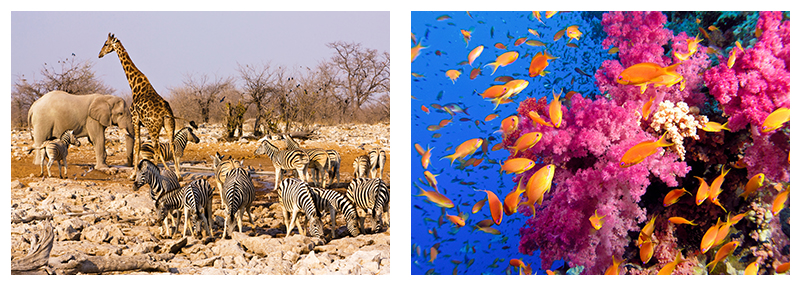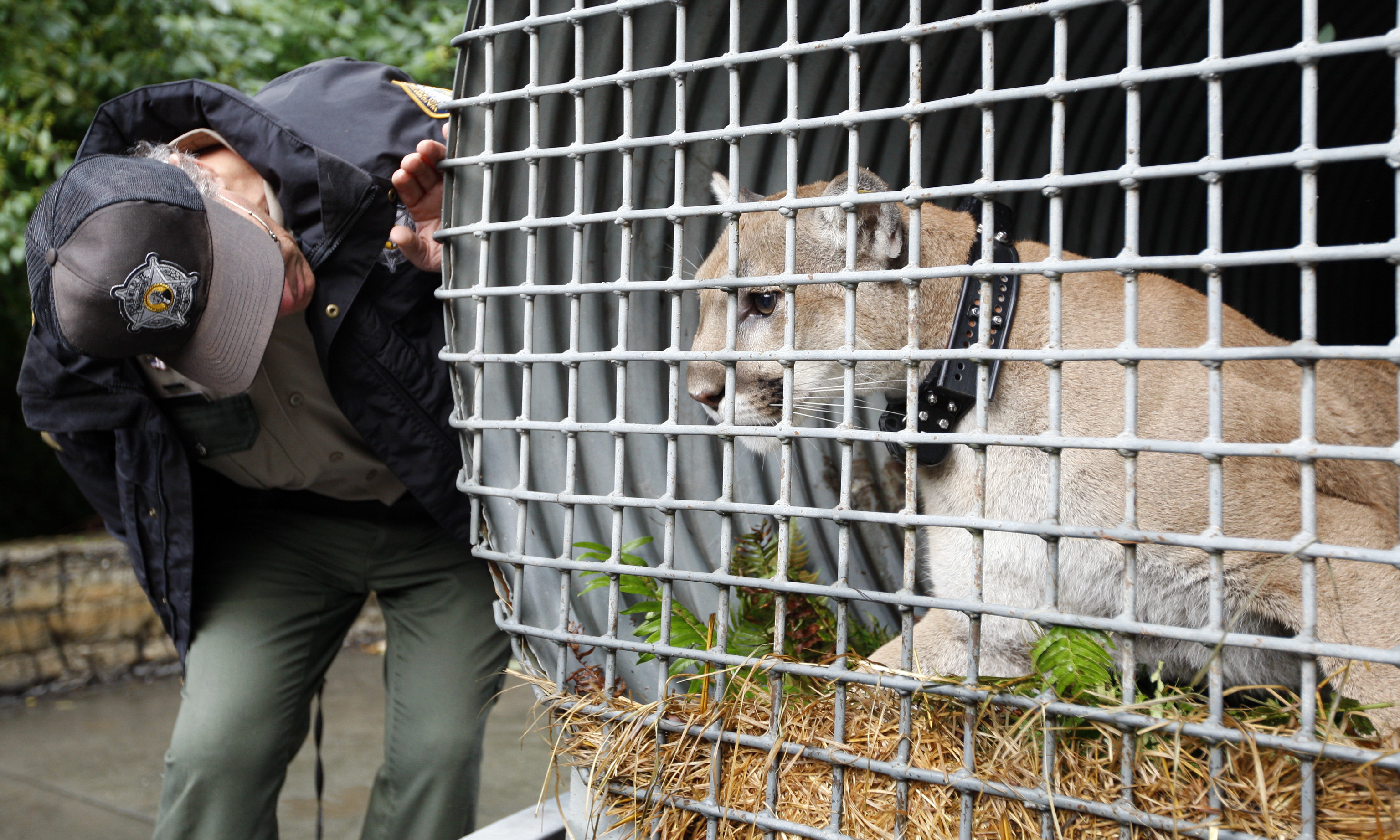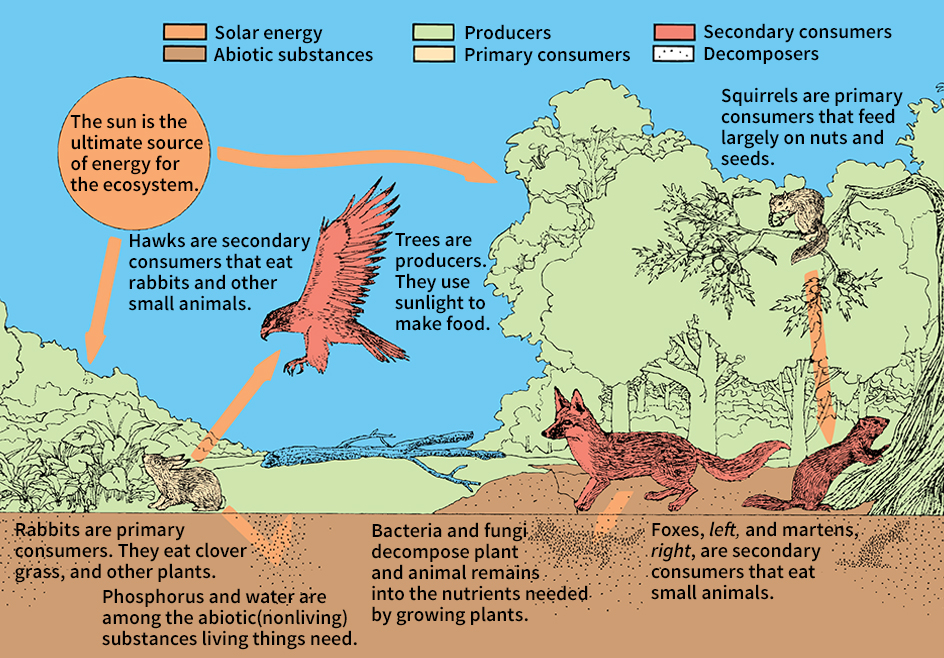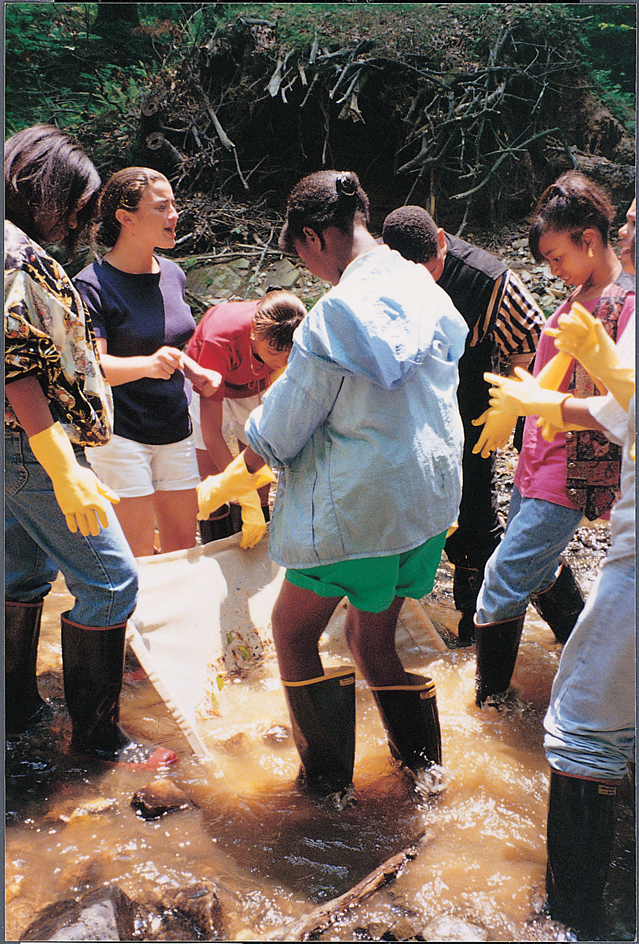Ecology, << `ee` KOL uh jee, >> is the branch of science that deals with the relationships living things have with one another and with their environment. Scientists who study these relationships are called ecologists.

The world includes a tremendous variety of living things, from complex plants and animals to simpler organisms, such as fungi, amebas, and bacteria. But whether large or small, simple or complex, no organism lives alone. Each depends in some way upon other living and nonliving things in its surroundings. For example, a moose must have certain plants for food. If the plants in its environment were destroyed, the moose would have to move to another area or starve to death. In turn, plants depend upon such animals as moose for the nutrients (nourishing substances) they need to live. Animal wastes and the decay of dead animals and plants provide many of the nutrients plants need.

The study of ecology is important because our survival and well-being depend on ecological relationships around the world. Even changes in distant parts of the world and its atmosphere affect us and our own environment.
Although ecology usually is considered a branch of biology, ecologists must employ such disciplines as chemistry, physics, computer science, and the social sciences. They also rely on such fields as geology, meteorology, and oceanography to study air, land, and water environments and their interactions. This multidisciplinary approach helps ecologists understand how physical environments affect living things, including human beings. It also helps them assess the impact of environmental problems, such as habitat loss, acid rain, and climate change.

Ecologists study the organization of the natural world on three main levels: (1) populations, (2) communities, and (3) ecosystems. They analyze the structures, activities, and changes that take place within and among these levels. Ecologists normally work out of doors, studying the operations of the natural world, though they increasingly use computers and mathematical models for their research. They often conduct field work in isolated areas, such as islands, where the relationships among the plants and animals may be simpler and easier to understand. For example, the ecology of Isle Royale, an island in Lake Superior, has been studied extensively. Many ecological studies focus on solving practical problems. For example, ecologists search for ways to curb the harmful effects of air and water pollution on living things.
Populations
A population is a group of the same species that lives in an area at the same time. For example, all the moose on Isle Royale make up a population, as do all the spruce trees. Ecologists determine and analyze the number and growth of populations and the relationships between each species and the environmental conditions.
Factors that control populations.
The size of any population depends upon the interaction of two basic forces. One is the rate at which the population would grow under ideal conditions. The second is the combined effect of all the less-than-ideal environmental factors that limit growth. Such limiting factors may include low food supply, predators, parasites, competition with organisms of the same or different species, climate, and disease. These factors help to keep populations from growing so large that they damage their environment.
The largest size of a particular population that can be supported by a particular environment has been called the environment’s carrying capacity for that species. Real populations often are smaller than their environment’s carrying capacity because of the effects of adverse weather, a poor breeding season, hunting by predators, or other factors.
Factors that change populations.
Population levels of a species can change considerably over time. Sometimes these changes result from natural events. For example, a change in rainfall may cause some populations to increase and others to decrease. Or the introduction of a new disease can severely decrease the population of a plant or animal species for some period of time. In other cases, changes may result from human activities. For example, power plants and automobiles release acidic gases into the atmosphere, where they may mix with clouds and fall to earth as acid rain. In some regions that receive large amounts of acid rain, fish populations have declined dramatically. For most wild plant and animal populations, habitat loss to agriculture, urban development, and other human activities is the greatest threat to their survival.

Communities
A community is a group of animal and plant populations living together in the same environment. Wolves, moose, beavers, and spruce and birch trees are some of the populations that make up the forest community of Isle Royale. Ecologists study the roles different species play in their communities. They also study the different types of communities, and how they change. Some communities, such as an isolated forest or meadow, can be identified easily. Others are more difficult to define.
A community of animals, plants, and other organisms that covers a large geographical area is called a biome. The boundaries of different biomes are determined mainly by climate. The major biomes include deserts, forests, grasslands, tundra, and several types of aquatic biomes.
The role of a species
in its community, together with the details of its habitat, is called its ecological niche. A niche consists of all the ways that a species interacts with its environment. It includes such factors as what the species eats or uses for energy; what predators it has; the amounts of heat, light, or moisture it needs; and the conditions under which it reproduces. Many species occupy a highly specialized niche in a given community. Various explanations have been proposed for this. Some ecologists feel that it results from competition—that is, two species try to fill the same niche, and then competition for limited resources forces one of the species out. Other ecologists maintain that a species that occupies a highly specialized niche does so because of the rigid demands of that particular role in the community. In other words, only one species occupies the niche not because it has outcompeted other species, but because it is the only member of the community capable of filling the niche. Both explanations could be correct, but for different reasons or different communities.
Changes in communities
occur over time in a process called ecological succession. This process occurs as a series of slow, generally predictable changes take place in the number and kinds of organisms in an area. Differences in the intensity of sunlight, protection from wind, and changes in the soil may alter the kinds of organisms that live in an area. Then, as the number and kinds of species change, the physical and chemical characteristics of the area undergo further changes. The area may reach a relatively stable condition called the climax community. Ecologists today recognize that many communities never reach the climax condition because of recurring natural disturbances, such as fire. Climate change also pushes communities away from predictable climax conditions.
Ecologists distinguish two types of ecological succession—primary and secondary. In primary succession, organisms begin to inhabit an area that had no life, such as a new island formed by a volcanic eruption. Secondary succession takes place after an existing community suffers a major disruption—for example, after an old-growth forest community is altered by fire or destroyed by logging. In this example, a meadow community of wildflowers and grasses may grow first, followed by a community of shrubs. Finally trees will reappear, and the area will eventually become a forest once more. Increasingly, ecologists view fires and other large natural disturbances as acceptable and even desirable. See Forest (Forest succession).
Ecosystems
An ecosystem is the most complex level of organization in nature. It is made up of a community and its abiotic (nonliving or physical) environment, including climate, soil, water, air, nutrients, and energy. Ecologists who try to link together the many different physical and biological activities in an environment are called systems ecologists. Their studies often focus on the flow of energy and the cycling of materials through an ecosystem. They generally use powerful computers to help understand the data obtained from field research and to predict future development.

Energy flow.
Ecologists categorize the elements that make up or affect an ecosystem into six main parts, based on the flow of energy and nutrients through the system: (1) the sun, (2) abiotic substances, (3) primary producers, (4) primary consumers, (5) secondary consumers, and (6) decomposers. A simplified ecosystem is illustrated in this article.
The sun provides the energy that nearly all primary producers need to make food. On land, primary producers consist mainly of green plants, such as grass and trees, which make food by the process of photosynthesis. Plants also need abiotic substances, such as phosphorus and water, to grow. Primary consumers include mice, rabbits, grasshoppers, deer, and other plant-eating animals. Foxes, skunks, snakes, and other secondary consumers—or predators—eat animals. Decomposers, such as bacteria and fungi, break down dead plants and animals into simple nutrients. The nutrients go back into the soil and are used again by plants.
The series of stages energy goes through in the form of food is called a food chain. In one simple food chain, grass is the primary producer. A primary consumer, such as a rabbit, eats the grass. The rabbit, in turn, may be eaten by a secondary consumer, such as a fox or a hawk. Decomposing bacteria break down the uneaten remains of dead grass, rabbits, foxes, and hawks, as well as animal body wastes. One of the food chains on Isle Royale has trees as primary producers, moose as primary consumers, and wolves as secondary consumers.
Most ecosystems have a variety of producers, consumers, and decomposers, which form an overlapping network of food chains called a food web. Food webs seem especially complex in many tropical and oceanic ecosystems.
Some species eat many things, but others have very specific food requirements. Such specialized primary consumers as koalas and pandas eat chiefly one type of plant. Koalas eat primarily eucalyptus and pandas eat primarily bamboo. If these plants died off, so would the animals.
Energy moves through an ecosystem in a series of transformations. First, primary producers change the light energy of the sun into chemical energy that is stored in plant cytoplasm (cell material). Next, primary consumers eat the plants, changing the energy to a different kind of chemical energy that is stored in body cells. This energy changes again when the secondary consumer eats the primary consumer.
Most organisms have a low ecological efficiency. This means they are able to convert only a small fraction of the energy available to them into stored chemical energy. For example, green plants can change only about 0.1 to 1 percent of the solar energy that reaches them into plant material. Most of the energy captured by the plants is burned up during plant growth and escapes into the environment as heat. Similarly, herbivores (plant-eating animals) and carnivores (meat-eating animals) convert into their own body cells only about 10 to 20 percent of the energy produced by their food.

Because so much energy escapes as heat at each step of the food chain, all ecosystems develop a pyramid of energy. Plants (primary producers) form the base of this pyramid. Herbivores (primary consumers) make up the next step, and carnivores (secondary consumers) form the top. The pyramid reflects the fact that more energy passes through the plants than through the herbivores, and more through the herbivores than through the carnivores. In many land ecosystems, the pyramid of energy results in a pyramid of biomass. This means that the total biomass (weight) of the plants is greater than the total weight of the herbivores, which in turn exceeds the total weight of the carnivores. In the oceans, however, the biomass of primary producers and animals is about the same. Photosynthetic organisms grow so rapidly in the oceans that they can support proportionately more animals than can the plants on land.
Ecologists have collected information on a pyramid of biomass on Isle Royale. They studied the relationship in the pyramid among plants, moose, and wolves. In one study, ecologists found that it takes 762 pounds (346 kilograms) of plant food to support 59 pounds (27 kilograms) of moose. This is the amount of moose needed to support 1 pound (0.45 kilogram) of wolf.
Cycling of materials.
All living things are composed of chemical elements and compounds. Chief among these are water, carbon, hydrogen, nitrogen, oxygen, phosphorus, and sulfur. All of these materials cycle through ecosystems again and again.
The cycling of phosphorus provides an example of this process. All organisms require phosphorus. Plants take up phosphorus compounds from the soil, and animals get phosphorus from the plants or other animals they eat. Decomposers return phosphorus to the soil after plants and animals die.
In natural, undisturbed ecosystems, the amount of phosphorus remains fairly constant. But when an ecosystem is disturbed, especially by human activity, the phosphorus often “leaks out.” This reduces the ability of the ecosystem to support plants. One way people alter the phosphorus cycle is by replacing forests with farmland. Without the protection of the forests, phosphorus is eroded with the soil and swept away into rivers and lakes. There, it often causes undesirable excess growth of algae. Eventually, the phosphorus becomes locked in sediments at the bottom of lakes or the sea. Because of this loss of phosphorus, farmers must use costly fertilizers to put the element back into the soil.
Changes in ecosystems
occur daily, seasonally, and, as in the case of ecological succession, over periods of many years. Sometimes changes take place abruptly, as when a fire sweeps through a forest or a hurricane batters a coastline. But most of the day-to-day changes, especially in the nutrient cycles, are so subtle that ecosystems tend to appear stable. This apparent stability among plants and animals and their environment has been called the “balance of nature.” In the past, this concept of balanced, largely unchanging ecosystems was thought to be especially descriptive of climax communities. But these earlier views were based on short-term studies. Now that ecologists have had an opportunity to study ecosystems over longer periods, they have had to alter some of their ideas.
Conclusions based on population studies from Isle Royale point out some of this change in thinking. For a long time, Isle Royale had neither moose nor wolf. Then, the first moose swam to the island in about 1900. By 1930, ecologists estimated that the moose population had reached about 3,000. There was evidence that the moose were eating many of the plants on the island. In 1933, the moose began to die of starvation. Ecologists had predicted this decline because they understood the food relationship between the moose and plants.
The moose population increased again between 1948 and 1950. However, about this time, wolves made their way to the island. As they killed moose for food, the wolf population grew. Eventually, an apparently stable balance of about 600 moose and 20 wolves became established. Ecologists pointed to Isle Royale as an example of the way in which predators can control prey and thus contribute to the development of stability in ecosystems.
But beginning in the mid-1960’s, the moose and wolf populations began to fluctuate. The apparently stable system, in which predators controlled their prey, turned out to be more complex. During the 1950’s, when it looked as if wolves were controlling the moose, the winters were characterized by an unusual pattern of deep snows followed by rain and then a hard freeze. This resulted in snow with a hard crust. Wolves could run easily on the surface of this snow, but the heavier-bodied moose broke through the crust. Thus the moose could not easily escape from wolves, nor could they effectively use their sharp, powerful hooves for defense. Under these conditions, the wolves could easily kill moose.
Around 1965, winters on Isle Royale returned to normal, and the wolves caught fewer moose. By the early 1980’s, the moose population had again become extremely large, even though the wolf population had also grown. Then the wolf population began to decline, despite the abundance of moose. By the late 1980’s, ecologists feared that wolves might disappear from Isle Royale. All of these population changes forced ecologists to reevaluate their thinking about how predators and prey control one another’s populations. Ecologists recognized that although wolves and moose certainly can influence the size of each other’s populations, these animal groups can completely determine one another’s population size only under unusual circumstances.
In the 1990’s, Isle Royale’s moose population declined again. Ecological studies indicated that changes in the availability of food plants and nutrients were important factors in this decline. For example, the moose would eat the leaves of aspen trees that became abundant after windstorms, but not the unpleasant-tasting needles from spruce and fir trees that replaced the aspen through succession. And since spruce and fir needles also did not decompose rapidly, the needles piled up on the forest floor, trapping nitrogen and other nutrients from entering the soil. Thus the quality of the soil declined, and the growth of trees was stunted. This has meant less food for the moose and a decline in moose population.
As for the wolves of Isle Royale, it appears that inbreeding and disease—not lack of moose—are behind the die-off of the population. Thus, predator-prey models of population control probably are oversimplifications, and what looks like a stable, balanced situation may in fact derive from the interaction of various changeable forces. Natural systems are filled with compensating mechanisms that help stabilize nature. Hence populations often need to be understood from the perspective of the entire ecosystem.
Applied ecology
Applied ecology is the use of ecological studies to achieve practical goals. It includes fields such as conservation biology, which seeks to slow the rate of human-caused extinctions. Ecological studies help us to preserve and manage natural resources and to protect the environment. Applied ecologists work with scientists from different fields to try to solve problems concerning the health and well-being of people, plants, and animals.
Ecologists are concerned about the rate at which people are depleting such nonrenewable resources as coal, gas, and petroleum, and about the pollution caused by their extensive use. Ecologists believe that if the human population and the economy continue to grow, such problems as depletion of fuels, pollution, deforestation, congestion, poverty, and the disruption of climate will also worsen.
An increasing concern is the loss of natural ecosystems and their many species as more forests and grasslands are converted to farmland, urban areas, and wasteland. Some people think that the studies and activities of ecologists conflict with people’s economic interests. But ecologists believe that ecological knowledge is essential for long-term economic well-being. They point out that the maintenance of natural ecosystems provides many benefits to society. For example, if air and water supplies are clean, people will be healthier, and medical costs will decrease. In addition, many ecologists think we can use the principles of ecology, such as energy flow, to understand human economies better. Ecologists suggest that everyone should learn about ecology and the environment, so that people can live in greater harmony with the rest of the world.
